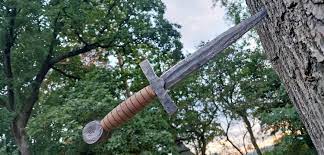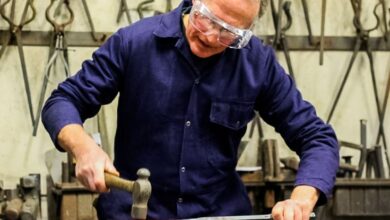Knife Making Course

A Complete Guide to Choosing the Right Knife Making Course
If you’ve ever dreamed of crafting your own blades from raw steel, enrolling in a knife making course is one of the best ways to begin. A structured course helps you learn essential skills, understand safety practices, and gain hands-on experience with professional tools. Whether you want to become a bladesmith or simply enjoy a new creative hobby, a knife making course can give you the foundation you need.
What You Learn in a Knife Making Course
1. Understanding Steel Types
A quality knife making course teaches students about different types of steel, including carbon steel, stainless steel, and tool steels. You’ll learn how each material reacts to heat, stress, and sharpening.
2. Forging and Shaping
This is the heart of bladesmithing. Courses often include:
- Heating the steel in a forge
- Hammering and shaping the blade
- Creating the bevel and blade profile
Instructors guide you step-by-step to ensure your technique improves with practice.
3. Heat Treatment
Heat treatment determines the blade’s strength and durability. A knife making course typically covers:
- Normalizing
- Hardening
- Quenching
- Tempering
This process gives your blade the balance of hardness and flexibility needed for long-term use.
4. Handle Design and Construction
Students learn how to choose handle materials such as wood, resin, or micarta. Courses may also include shaping the handle, fitting pins, and achieving a comfortable grip.
5. Finishing and Sharpening
Polishing, sanding, and sharpening bring the blade to life. A good knife making course helps you finish your knife to a professional standard.
Why Take a Knife Making Course Instead of Learning Alone?
Expert Guidance
Instructors help you avoid common mistakes and teach small details you might miss on your own.
Access to Professional Tools
Knife making requires specialized equipment such as forges, grinders, and anvils. A course gives you access to these tools without the cost of buying everything yourself.
Safety Training
Working with heat and metal can be dangerous. A structured knife making course emphasizes safety, protective gear, and proper tool handling.
Faster Skill Development
Hands-on instruction accelerates the learning process, helping you progress from beginner to confident maker more quickly.
How to Choose the Best Knife Making Course
When searching for a course, look for:
- Experienced instructors or certified bladesmiths
- Small class sizes for personalized attention
- Hands-on lessons rather than only demonstrations
- Clear beginner-friendly curriculum
- Safety-focused environment
- Previous student reviews or sample work
Also consider whether you prefer a short weekend course, an intensive workshop, or a long-term program.
Who Can Join a Knife Making Course?
Knife making is suitable for:
- Complete beginners
- Hobbyists
- Outdoor enthusiasts
- Craftspeople
- Anyone interested in metalwork or custom tools
Most courses welcome people with no prior experience, making it easy to get started.
Final Thoughts
Enrolling in a knife making course is an excellent way to learn a rewarding craft, develop new skills, and create a knife you can proudly use or display. Whether your goal is a new hobby or the beginning of a future bladesmithing career, the right course can set you on the path to mastering the art of knife making.
Below is a unique, easy-to-read FAQ section that naturally includes your keyword “knife making course.”
FAQ: Knife Making Course
1. What is a knife making course?
A knife making course is a hands-on workshop or training program that teaches you how to design, forge, shape, heat-treat, and finish your own knife. It’s suitable for beginners and hobbyists who want to learn bladesmithing safely and correctly.
2. Do I need any experience before joining a knife making course?
No experience is required. Most courses are designed for beginners and guide you through every step, from handling tools to completing your first blade.
3. What tools do I need for a knife making course?
Typically, you don’t need to bring anything. Most programs provide essential tools like forges, grinders, anvils, hammers, and safety gear. Some advanced courses may require personal tools, but this is usually stated beforehand.
4. How long does a knife making course take?
Course length varies. Some workshops last 1–2 days, while more detailed or advanced classes may run for a week or longer. Choose a duration based on your interest and skill level.
5. Will I get to take home the knife I make?
Yes! In most cases, you leave the knife making course with a fully finished knife that you forged and shaped yourself.
6. Is a knife making course safe?
Yes, as long as safety rules are followed. Instructors provide training on proper forging techniques, protective gear, and safe tool handling to reduce risks.
7. How much does a knife making course cost?
Prices differ based on location, duration, and instructor experience. On average, courses range from $100 to $600, with premium bladesmith classes costing more.
8. Who teaches a knife making course?
Courses are often taught by professional bladesmiths, blacksmiths, or experienced knife makers. Some are even run by certified smithing schools or workshops.
9. What types of knives can I make?
Depending on the course, you may create:
- Chef’s knives
- Hunting knives
- Utility knives
- Damascus steel blades
- Custom-designed knives
Always check the course details to see what styles are offered.
10. Is a knife making course suitable as a gift?
Absolutely! Many people book a knife making course as a unique gift for birthdays, Father’s Day, or anyone who loves craftsmanship and hands-on activities.


